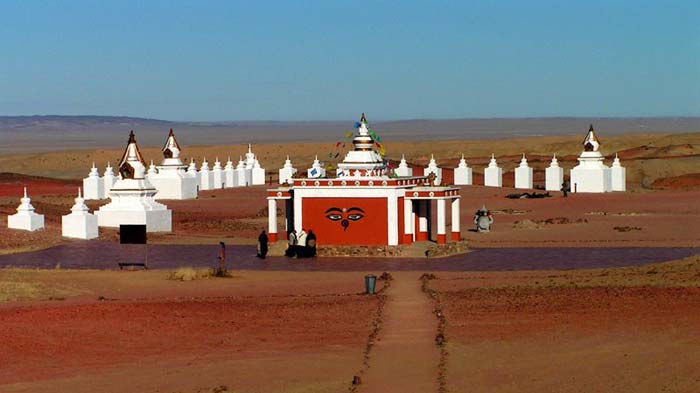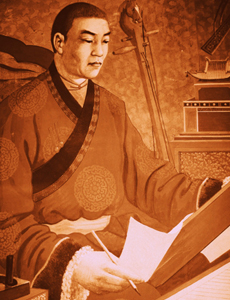Please enjoy your tailor made trip with our experienced guides .
Khamaryn Khiid or Khamar Monastery is known as the World Energy Center along with its surrounding mountains.
A writer, architect, composer, poet, painter, and physician Danzanravjaa (1803-1856), who belonged to the order of Red Hat Buddhism in Mongolia, initiated the Khamaryn Khiid Monastery in 1820 when he was 17 years old based on his observation of the area’s spiritual energy.
Danzanravjaa used to fight against the rigid class and gender distinctions, an outspoken critic of the society.
Until its destruction in 1937 by the communists, the Khamaryn Khiid was an important cultural, and education center in Mongolian Gobi Desert: a theatre called Namtar Duulah Datsan, a library and non-religious children school for culture, math, natural science, history, Mongolian and Tibetan literature are the examples. At its peak, the monastery housed up to 5000 monks in the over 80 temples.
Until its destruction in 1937 by the communists, the Khamaryn Khiid was an important cultural, and education center in Mongolian Gobi Desert: a theatre called Namtar Duulah Datsan, a library and non-religious children school for culture, math, natural science, history, Mongolian and Tibetan literature are the examples. At its peak, the monastery housed up to 5000 monks in the over 80 temples.
A monastery and some meditation caves remained from the communist purge. After 1990, the old temples, stupas, and ceremonial sites have been reconstructed and rebuilt. The monastery is one of the favorite places for the locals, the worldwide meditators, and worshippers.
Worshippers attend the religious ceremonies in the temples followed by energy increasing rituals in Shambala.
There are several meditation caves where Saint Danzanravjaa and his disciplines meditated. Mother’s womb cave, bell tower, a museum display religious books, shrines, and artifacts hidden successfully during the communist purge are worth to visit and pay respect.
Some dinosaur fossils discovered at Luutiin Tsav/ cliffs of Dragons to the southeast of the monastery.
c 17-year-old monk of the Nyingma red hat school of Buddhism. Danzanravjaa chose the site of the monastery believing the surrounding area radiated with a spiritual energy fostered by the Gobi desert. To the north of the monastery lie a series of caves where monks would retreat and practice high levels of meditation for 108 continuous days (108 being a sacred number in Buddhism).

Often referred to as “the Terrible Noble Saint of the Gobi”, Danzanravjaa was an educator, poet, and harsh critic of Mongolian society. He supported the idea of public education and respect for women and he founded the monastery in the desert to serve as a model of a more enlightened society. The monastery was deeply engaged with the surrounding community and contained a public library, a museum, and a poetry recital hall. It was also home to Mongolia’s first ever professional public theater, the Namtar Duulakh Datsan (“story singing college”) which sponsored a touring company of some 300 artistes that performed throughout the Gobi region. By the 1830s the Khamar Khiid included a school for children, the Khuukhdiin Datsan that provided a non-religious education in Mongolian and Tibetan literature, mathematics, natural science, and history.
Day 1: Arrival Morning or afternoon airport pick-up depending on flight time. Accommodation in a 4-star hotel in Ulaanbaatar. Lunch and dinner at the Altangadas Restaurant, depending on the flight schedule. Itinerary may be adjusted based on flight times.
Day 2: Breakfast at the hotel at 08:30. Depart for Choirt at 09:00. Lunch in Choirt at 13:00. Depart for Khamar Monastery at 14:00. Check-in at the camp at 18:00. Dinner followed by sunset photography in the desert at 19:00.
Day 3: Visit the energy center to accumulate energy and witness sunrise at 05:00. Breakfast at the camp at 08:30. Hiking tour and visit Khamar Monastery at 09:00. Lunch at 13:00. Camel riding and free exploration begin at 14:00. Dinner at 18:00.
Day 4: Breakfast at 08:30. Depart for Sainshand at 09:00. Visit the local museum at 10:00. Lunch at 12:00. Depart for the city at 13:00. Dinner at the VERANDA restaurant at 19:00.
Day 5: Breakfast at 08:30. Depart for the airport based on flight time to conclude the tour.
2 PAX 2196$
3 PAX 3294$
4 PAX 4392$
5 Pax+ each person 898$
For children of a family trip
One free space for every 8 pax
Low season discount: 5-10% (could be negotiate)
Please contact us for more trip details.
Shambala Tour – Visit to the Khamar Monastery and Energy Center is not include challenging physical or demanding activities. Traveling in Mongolia always requires long driving through changing landscapes and scenic views. Even though, we developed the itinerary with a combination of evenly distributed daily diving and activities. The approximate daily driving is 4.5-5.5 hours. However, the driving time is subject to change due to weather and road conditions when driving on rough roads. You also cross several rivers and streams.
Tour meals are included according to the itinerary. In the countryside, ger camps serve occasional European but mainly Mongolian meals. Meat is the main ingredient for meals and is served for lunch and dinner along with vegetables, salads, and soups. There will be more meat in traditional Mongolian meals. A typical breakfast is tea or coffee, bread, jam, butter, eggs and sausage. There are some cookies, cheese, cereals, pancakes and more at some of the ger camps for breakfast. For lunch, meals include salads, Mongolian soups and a main course (pasta, rice, vegetables, beef/mutton/chicken/fish near lakes/rivers), and dessert and tea. Salads, a main course, a dessert, and tea will be served for dinner. With nomads, you will try authentic Mongolian meals. Different types of meals offered simultaneously are not customary in Mongolian tradition. If you are a vegetarian or have other dietary restrictions, please inform us in advance, and we will make arrangements accordingly. About lunch, it will be packed as a picnic. More information on Mongolia meals
During the trip, you will stay at the ger camp for 1 day and 2 days centrally located hotel stay in Ulaanbaatar. Compared to the other tourism well-developed parts of Mongolia, the ger camp are of a local standard, run by local people. Please get more information about the ger camp.
Most of our company guides are English speaking. We also have some guides who speak German, French, Spanish, Italian, Russian, and Japanese. They are all friendly, helpful and most of them were born and grown in the countryside. Therefore, they have good knowledge about every aspect of Mongolia, good at horse trekking and have at least three years or more years of guiding experience.
The tours were designed with four wheels driving Japanese SUVs driven by experienced, friendly, and good mechanic-drivers. Different car types are available upon request, and you may check the travel vehicle details at Mongolia transportation
The most suitable time is between 25 May and 10 September. During this period, the weather is warm and enjoyable. Khentii Mountain Range domains in northeastern Mongolia and is rich in rivers, streams, and wetlands. This part of Mongolia receives a relatively high prescription and tends to be cooler. The mountains have high-growing grasses and flower-carpeted valleys.
The average day temperature in June, July, and the first half of August are +25 to +28°C, and the highest is +35°C in July. Evening and night temperatures may drop by 10-22°C. The temperature could dramatically fall to +7°C if it rains. You may experience occasional chill wind and snowfalls in May, the beginning of June, September, and October. For your pre-departure preparation, please check the discovery tour packing list.
To plan your dream holiday or customize the tour exclusively for you, please checkthe things to do in different part of Mongolia and the attractions in Central Mongolia



© 2025 Asiatic Uncharted Travel. All right reserved. Developed by Mind Agency